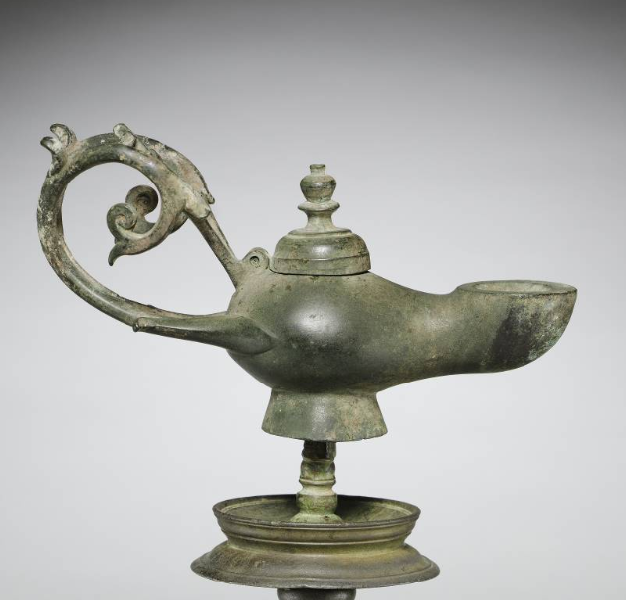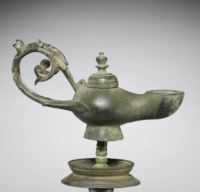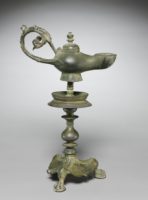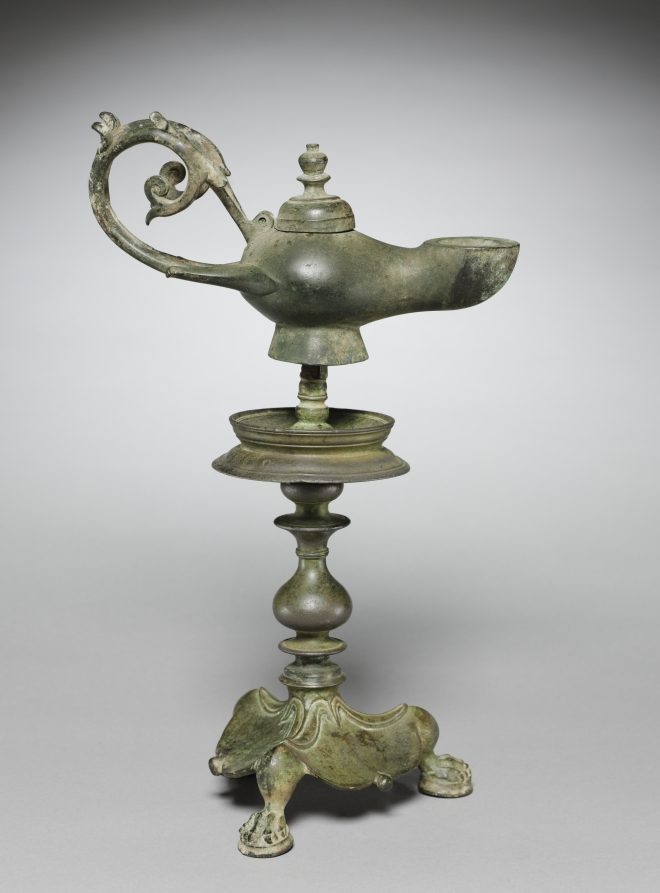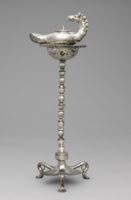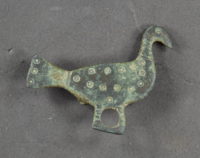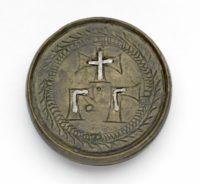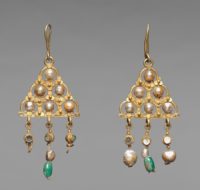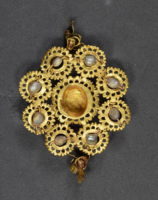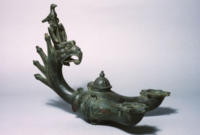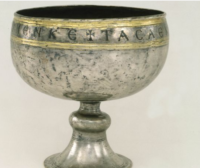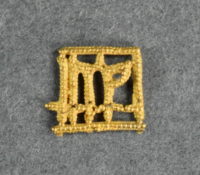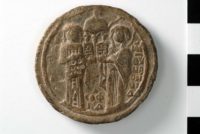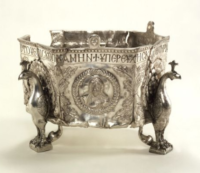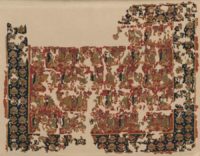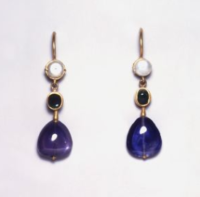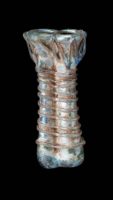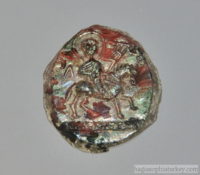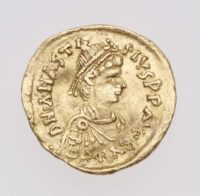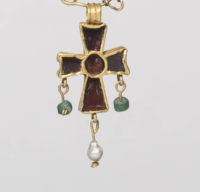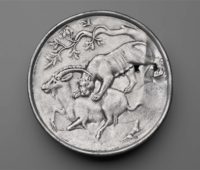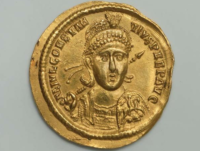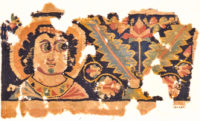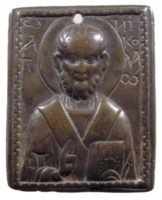Lamp and Stand, Period: Early Byzantine, circa 400s. 34.8 x 13.5 cm (13 11/16 x 5 5/16 in.) Material: Bronze. The Cleveland Art Museum Hours: Tuesdays, Thursdays, Saturdays, Sundays 10:00 a.m.–5:00 p.m. Wednesdays, Fridays 10:00 a.m.–9:00 p.m. Closed Mondays.
Lamp and Stand, Period: Early Byzantine, 4th century. Materials: Silver. 9.2 x 16 x 7 cm (3 9/16 x 6 1/4 x 2 3/4 in.). The Cleveland Art Museum Hours: Tuesdays, Thursdays, Saturdays, Sundays 10:00 a.m.–5:00 p.m. Wednesdays, Fridays 10:00 a.m.–9:00 p.m. Closed Mondays.
Brooch, in the form of a dove. Period: Early Byzantine, circa: 6thc-7thc. Material: Bronze . British Museum is closed 24, 25 and 26 December and 1 January, but is open every other day of the year. Fast facts about the British Museum: Founded: 1753, Collection size: 8 million objects, Oldest object in the collection: Stone chopping tool (nearly 2 million years old).
Copper Alloy Weight, Period: Early Byzantine, 6thc-7thc, discoidal with double-grooved convex profile; lathe-turned with rims; face engraved with double wreath enclosing cross above denominational mark, both inlaid with silver. British Museum is closed 24, 25 and 26 December and 1 January, but is open every other day of the year.
Earrings (pair), Period: Early Byzantine; circa: 600s; Materials: gold, pearls, glass, and emeralds. The Cleveland Art Museum Hours: Tuesdays, Thursdays, Saturdays, Sundays 10:00 a.m.–5:00 p.m. Wednesdays, Fridays 10:00 a.m.–9:00 p.m. Closed Mondays.
Pendant; Material: gold. Period: Late Roman; Early Byzantine; (5thc.) Found: Medinet el-Faiyum, Egypt. Open-work; composed of central setting with a stone (now missing), around which are eight small medallions, with a pearl in the middle of each. British Museum is closed 24, 25 and 26 December and 1 January, but is open every other day of the year.
Griffin’s Head Lamp, Period: Early Byzantine, circa 4th-5th century. Purchased from George Zacos (dealer), Istanbul by Dumbarton Oaks Research Library and Collection, Washington, DC, July 1962. The museum is open to the public Tuesday through Sunday, 11:30 a.m.–5:30 p.m., except for federal holidays.
Chalice, Period: Early Byzantine, ca. 527 – 565 A.D. Materials: silver and niello. The museum is open to the public Tuesday through Sunday, 11:30 a.m.–5:30 p.m., except for federal holidays.
Personal gold ornament; Period: Early Byzantine Period; circa: 6thC-7thC. Length: 8 millimetres, Width: 7 millimetres. British Museum is closed 24, 25 and 26 December and 1 January, but is open every other day of the year. Fast facts about the British Museum: Founded: 1753, Collection size: 8 million objects, Oldest object in the collection: Stone chopping tool (nearly 2 million years old).
Virgin Mary (right) and Emperor Justinian (left), holding between them a model of the church of Hagia Sophia. Period: Middle Byzantine, 12th. century.
The museum is open to the public Tuesday through Sunday, 11:30 a.m.–5:30 p.m., except for federal holidays.
Hexagonal Censer with Christ, Peter and Paul, Period: Early Byzantine, circa Mid 6th Century A.D. It is embellished with richly symbolic images-repoussé portraits of Christ, Saint Peter, and Saint Paul, and supports of peacocks and dolphins. Solid cast, the supports are attached to the censer by rivets. The museum is open to the public Tuesday through Sunday, 11:30 a.m.–5:30 p.m., except for federal holidays.
Fragment of a Large Hanging, Period: Early Byzantine; circa: 6th century, Made in: Egypt. Materials: tapestry weave (with plain tabby borders): wool and linen. The Cleveland Art Museum Hours: Tuesdays, Thursdays, Saturdays, Sundays 10:00 a.m.–5:00 p.m. Wednesdays, Fridays 10:00 a.m.–9:00 p.m. Closed Mondays.
[xyz-ihs snippet="Cleveland-Museum-Art-Booking-Deals-Finder"]Pair of Earrings. Materials: Pearls, Emeralds, Sapphires, Gold and Gems. Period: Early Byzantine, circa: early 5th century. The museum is open to the public Tuesday through Sunday, 11:30 a.m.–5:30 p.m., except for federal holidays.
Double Costmetic Tube (balsamarium). Period: Early Byzantine, circa: 5th–6th century A.D. Dimensions: Height: 11.6 cm (4 9/16 in.) Material: Glass. The MFA is open 7 days a week. Monday and Tuesday 10 am–5 pm, Wednesday–Friday 10 am–10 pm, Saturday and Sunday 10 am–5 pm.
Pendant depicting the scene “Triumphal Entry” . Period: Early Byzantine; circa: 5-6th century. Material: glass. In the Istanbul Archaeological Museum collections, there are rich and very important works of art belonging to various civilizations from the regions from Africa to Balkans , from Anatolia and Mesopotamia to Arab Peninsula and Afghanistan that were in the borders of the Ottoman Empire.
Tremissis of Anastasius I, Gold, Period: Early Byzantine, circa: A.D. 491–518. Mint: Constantinople. The MFA is open 7 days a week. Monday and Tuesday 10 am–5 pm, Wednesday–Friday 10 am–10 pm, Saturday and Sunday 10 am–5 pm.
Chain with Pendant Cross, Materials: gold, glass, pearl, garnet, and sapphire. Period: Early Byzantine, circa 500s. The Cleveland Art Museum Hours: Tuesdays, Thursdays, Saturdays, Sundays 10:00 a.m.–5:00 p.m. Wednesdays, Fridays 10:00 a.m.–9:00 p.m. Closed Mondays.
Plate with a Tigress Attacking an Ibex, Eastern Mediterranean, Material: Silver. Period: Early Byzantine circa: A.D. 450–525. The MFA is open 7 days a week. Monday and Tuesday 10 am–5 pm, Wednesday–Friday 10 am–10 pm, Saturday and Sunday 10 am–5 pm.
Solidus of Constantius II (333–361). Material: Gold. The museum is open to the public Tuesday through Sunday, 11:30 a.m.–5:30 p.m., except for federal holidays.
Tapestry fragment Egyptian (Coptic), Period: Early Byzantine, circa: 5th-6th century A.D. Material: silk. The MFA is open 7 days a week. Monday and Tuesday 10 am–5 pm, Wednesday–Friday 10 am–10 pm, Saturday and Sunday 10 am–5 pm.
Small icon of St Nicholas. Period: Late Byzantine; circa: First half of 13th century. Materials: bronze. The Benaki Museum of Greek Culture is housed in one of the most beautiful neoclassical-style buildings in Athens, near the National Garden and the Hellenic Parliament. It was converted into a museum in order to shelter the collections of Antonis Benakis and was donated to the Greek nation by himself and his three sisters, Alexandra, Penelope and Argine. Following its most recent refurbishment (1989–2000), the building houses a unique exhibition on Greek culture arranged diachronically from prehistory to the 20th century.


